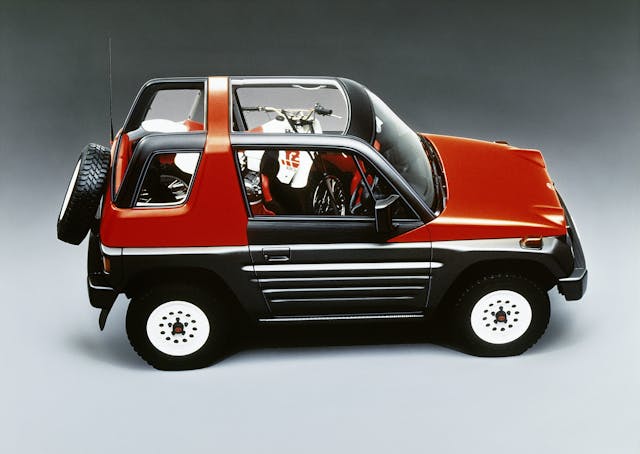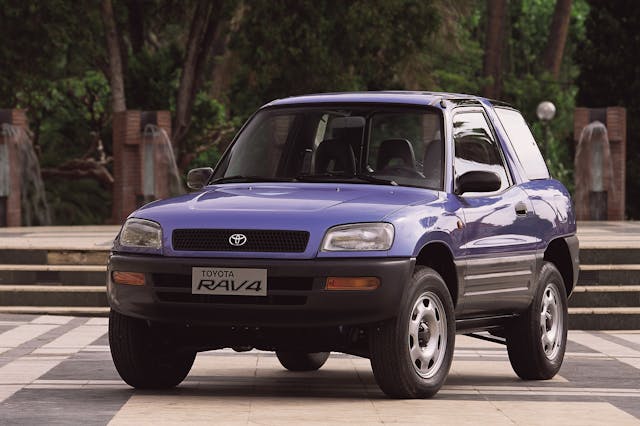Media | Articles
The Subaru Outback Proved Goldilocks Was Right
We’ve previously seen the successes and failures of the growing SUV boom of the 1990s, an era when the economy grew stronger and we seemingly could do nothing wrong. The stock market saw unprecedented growth, there was bipartisan support for a nebulous agreement called NAFTA, and we were still bringing it home to the USA. (Well, allegedly). It was a monumental shift, with prosperity easily seen in our driveways: street-minded Sport Utility Vehicles were dominating well-heeled zip codes around the country.
In some ways it was living a lie, a gilded notion that somehow the SUV was superior to the station wagon and the minivan it was replacing en masse. Yet this genre opened up a new market for a Goldilocks utility, one that combined the attributes of station wagon and SUV into a porridge that was “just right.” This fable of a utility came out at the perfect moment, and it likely saved the company that implemented it. Meet the Subaru Outback for 1995.
This famous ad featured actor Paul Hogan and a Subaru station wagon with a distinctly Australian theme: Outback. Based on the Subaru Legacy wagon, the Outback sported beefier body cladding with a deep chin front bumper, recessed fog lights with utilitarian covers, two-tone paint, a mild suspension lift, a raised roof, and Subaru’s familiar (but not yet mainstream) all-wheel-drive powertrains. Ah, to live in a world when most passenger cars were front- or rear-wheel drive, but not both at the same time!



Subaru has a legacy (sorry) of mandating all-wheel drive in its vehicles, so the Outback’s unique all-weather, multi-terrain design was a natural fit. They even marketed the Outback as “The World’s First Sport Utility Wagon,” which had the potential to resonate around the country thanks to the success of the Ford Explorer and Jeep Cherokee as reference points. But Subaru’s future was far from set in stone: Resting halfway between the bad old days of hustling Subaru 360s and our current reality of mainstream success, things must have been stressful back for Subaru USA in the mid-1990s.
The Outback panned out, becoming the right product for the time: Previous all-weather wagon designs from AMC, Honda (Wagovan), Toyota (Tercel Wagon), and Mitsubishi (Dodge Colt Vista) beat Subaru to the punch, but the market wasn’t ready to embrace their higher profile, pavement-optional prowess. But the Outback didn’t just draw new customers, as its underlying engineering upgrades over a regular Legacy wagon couldn’t alienate their Loyale-ists (sorry). Those folks embraced the AWD Japanese import for their snowy climates, and subsequently earned the brand a reputation for toughness and durability. The Outback was completely brand-appropriate, making for a rare slam dunk from a smaller automaker.
Marketplace
Buy and sell classics with confidence
Yet when introducing the first-ever Outback to Motorweek’s audience, host John Davis curiously avoided the low-hanging fruit of referencing the now-popular SUV. Instead, he led with the space-efficient minivan, eschewing the Outback’s recipe for success: doing off-road worthy things without the performance and fuel economy penalty of actual SUV ownership.
Performance from the Outback’s signature powertrain and suspension design left Motorweek staffers impressed with its ability away from pavement, but they wisely noted the independent suspension and communicative steering were impressive on the streets. That raised roof is still lower than a minivan or SUV, but made for a roomier rear cabin for adults and bulky cargo. It seems like an awkward middle ground to pursue, but it became a sweet spot in the market. And we all know where this is going…


The passenger car-based, almost-SUV nature of the CUV (crossover utility) now thrives in the world where family sedans, minivans, and station wagons once thrived. They are all two-box hatchbacks heavily based on a unit-body construction shared with a more traditional family car. And their inherent advantages (both for the consumer and manufacturer) are clearly seen in the Motorweek review. The SUV craze matured into a CUV phenomenon. Goldilocks’ preference in porridge wasn’t a one-off, apparently.

It’s come to the point that CUVs should be referred to as cars, with everyone from Kia to Lamborghini making fat stacks of cash off the genre. While Mustang EV crossovers and Porsche Macans likely infuriate the purist, everyone follows the money. There’s ample fiscal motivation to add height while removing truck-like bulk.
The first Subaru Outback was the first “car” to make the CUV genre both relevant and cool, proving that Goldilocks was very much right in her porridge preference. And you can’t do much better than that for your long-term, ahem, legacy.










I’ve owned a 99 Legacy wagon, 97 Legacy wagon parts car that did field laps, and a 2018 Outback.
I much prefer the look of the older Subaru, and despite it being archaic and not-fancy I preferred driving the 99 and the comfort of it more.
Our current family “Goldilocks” is a 2013 Tiguan with the little turbo engine. It fell into our hands from a relative and has been a revelation. I’d never looked twice at a Tiguan and still don’t. I probably would buy another though (though if a solid 90s Legacy was available…)
One of my favorite cars,ah!.. em’ (cuv) was a 1988 Subaru GL-10 , in a year or two later would be named the Loyale , it had a 120hp, 1.8l boxer a 5-speed w/ a dual range transfer case , you could actually shift through 10 forward gears if you really liked rowing the cogs! Using both shift levers , this I didn’t actually try , I just look left it in 4, high , these unlike later Subarus could be driven in 2 wheel drive, another neat feature, adjustable spring perches in the rear , you could set the rear ride height ,they were adjusted just like your pricey FK, or Tein coilovers, I’m assuming the reasoning for Subaru was to keep the car level if you were a New England carpenter and kept/stored all your tools ,table and mitre saws included in the wagon, it was this or a late 70’s 244, for that eccentric carpenter that we’ve all seen, now I’m rambling, anyway my GL-10 was white with a red hatch , pea green and brown front fenders and red passenger side doors ,I figured it looked better than rust holes , that car could climb over hill and dale ,I was fond of the fire roads all over Maine, carried two MTN bikes in the back without them piled on top of each other , got great mileage, and sounded like a Cessna, ,it is still the best S/CUV I ever owned I still miss it and would happily pay 300$ for one again!
Unfortunately, the old GL’s couldnt be driven in 4WD on dry pavement, not until the Full Time 4WD transmissions came out in the late 80’s. Then in 91 (USDM) when Symmetrical AWD came came out in the Legacy platform and could be driven on all surfaces
I owned the 2005 Legacy GT wagon which was the lowered with no gray plastic body cladding on it. It was so clean and quite quick with it’s turbo power. I loved that wagon and I still miss it. I don’t care for the new CVT transmission versions of the Outback. They do sell a bunch of them.
I also had an ’05 LGT wagon. Loved that car. It was the “grown-up WRX” I always wanted.
Yep. It was definitely a sleeper, because no one knows what a Legacy GT wagon is, they assume it’s an Outback with the non turbo 2.5 liter which is slow. Most of the 3.5L V6 class “luxury cars” would have seen my wagons taillights back in the day o straight line acceleration I got the Japanese spec.B shocks/springs from a JDM wagon, upgraded the sway bars and did a Cobb Stage 1 tune. 300hp and it could handle. I remember embarrassing some very expensive cars in the twisties. Oh I miss that car!
Bought a new 96 outback. We loved it and kept it 15 yrs. What we hated was the crooked dealer.
Which is why we’ll never own a Subaru again. And why we took a chance and bought a Mitsubishi Outlander plug in hybrid. We never see the dealer because in the six yrs we’ve owned it not one single thing has gone wrong with it . Period.
Having owned 4 Outbacks (giving two away to family members), they have been the best and easiest vehicle to work on (once you get your hands dirty). The stealership charging $450 for a half axle? No sir! For a little work and a fairly inexpensive part price….you can “learn” to do it yourself, thus from here after….
My first Outback 2004, had 24K miles on it when obtained in 2008. I finally sold it to a person in need of transportation and I had no problem with it having 485K miles on it when I sold it, in 2016. BY the way, it’s still running.
Though I do not care for the “infotainment” systems, especially since they are experiencing problems.
I love how easy they are to work on. At some point, I have had every driveline part off of my ’95 rallycross Legacy, and the only tools that I needed other than a basic socket set was a 12-pt 14mm that my friend’s dad machined down to fit in the water jacket to undo the bolts to split the block.
I had 3 Outbacks, 2 ’99s and an ’09. After I had my knees replaced I found it easier to slide into a Forester Touring. So far I’m on Forester Touring #4 (I trade them ever 3 years or so) and never looked back. Nice little rides.
Good info but not accurate! The first subaru with full time 4wd was in 1987, came with rhb5 turbo, body kit, lock center diff, high-low shift gear and also LSD.
I don’t think I suggested that. I only said it was based on the Legacy and was the first “Sport Utility Wagon”. (Which was Subaru’s words, not mine.)
I bought the first-gen Subaru Legacy Outback Wagon new in ’96. Absolutely fantastic vehicle, save for the DOHC 2.5L engine which sometimes liked to run on only 3 cylinders and never got good fuel economy. Great handling until the last 2/10ths or so, unbelievable snow prowess, and exceedingly well-suited to my needs at the time. Excellent highway ride, effortless cruising at 80mph. An absolute wonder for the time, far better all-arounder than I’d expected. Miss that car today!